Thanks to master organizer Marie Kondo, many of us now evaluate our belongings based on the principle that things we love should bring us joy. But too often, we fail to bring the same level of scrutiny to the rest of our lives. Just as passivity can leave us buried under a lot of junk we don’t need, so can we aimlessly fall into patterns of behavior that don’t serve us well and wind up leading a muted life.
In our new book, Designing Your Life, we draw from design principles and techniques to explain how to create a life you love. The first step in this process is to understand yourself—which means taking a close look at how you’re faring in the areas of health, work, play, and love.
The Good Time Journal is a technique to facilitate this process. The goal is to make you notice which activities make you happy and give you energy, and which ones don’t. The journal gives us a framework for reflection so that we can better tease out what’s working in our lives and use that knowledge to shape our futures.
To get started, we recommend thinking about the last time that you were on cloud 9—an experience that gave you a glimpse of adrenaline-induced ecstasy, if only for a moment. It could be the feeling you had when you got a great new job offer, fell in love, finished a marathon or traveled to a beautiful country. This kind of memory is called a peak experience. Examining it can help you to look at events in the future, designing a more fulfilling life in the process.
Write down a peak experience you’ve had. For our friend Savannah, who we’ll use as an example, it was delivering the keynote speech at a large international technology conference.
Now apply the AEIOU method. Ask yourself the following questions and write down your observations. You can apply this framework to future reflections you do on your activity log as well.

Activities: What were you actually doing? Was this a structured or unstructured activity? Did you have a specific role to play (presenter, leader, researcher, etc.) or were you simply a participant in or attendee of the experience?
In Savannah’s case, the event was structured. The keynote had been planned for months and her role as a presenter was clearly defined. However, she was able to make changes to her content up until the night before the event, which is unconventional and unstructured compared to most speaking events. She found that she really enjoys that spontaneity and would be bored if she had to deliver a speech that was “in the can” weeks before the event.
Environment: Our environment has a profound effect on our emotional state. A crowded football stadium will bring some people joy; others will find happiness in a cathedral. Notice where you were during the activity. What kind of place was it, and how did it make you feel?
Savannah is admittedly a bit of a ham. She delivered this presentation in a large theater. She, unlike most of us, feels at her best when public speaking and finds her flow moments on stage, when she feels connected to her audience. It also helped that this event happened in New Zealand, one of her favorite countries, and that travel is always the greatest gift to her as a presenter.
Interactions: What were you interacting with during this experience—people, animals, machines? Was it a new kind of interaction or one you are familiar with? Was it formal or informal?
There were over 500 people in the audience for Savannah’s talk, a large crowd for her. She gets energy from inspiring other people, so the balance of a formal presentation followed by informal follow-up conversations after the speech brought her joy.
Objects: Were you interacting with any objects or devices, such as smartphones, tools or toys? What were the objects that created or supported your feeling engaged?
Savannah sound-checked the presentation the day before and made sure that the remote/laser pointer had fresh batteries. She always uses a certain remote and wears her lucky shoes. When the tech team asks Savannah to “mic-up”, she knows it’s go-time. Knowing that she has all her “tools” ready to go energizes her.
Users: Who else was there, and what role did they play in making it a positive or negative experience?
It is not often that Savannah’s friends and family can attend her speaking gigs. But she’s spent a lot of time in Auckland lately and, because this event was booked so far in advance, many of her friends were able to make it. This made this gig particularly special for her.
The upshot
Zooming in on this experience with the AEIOU method allowed Savannah to see how much her friends and family really make a difference when she’s presenting. She also became aware that, while she is often lonely on the road, she draws energy from building deeper relationships with people in the cities she visits all over the world. She can apply this knowledge by making sure to book her return flights on business trips a day later, so that she can stick around after giving a presentation to mingle and have informal conversations with the people she meets rather than rush off to the airport.
Once you’ve gotten the hang of the AEIOU method, start logging the activities that punctuate your days. The more detailed your reflections, the more insightful they will be. Push beyond “Staff meeting left me feeling great” and aim for more “Presenting at the staff meeting gave me energy and increased my sense of purpose at the office.” “Filing expense report was annoying” might become “Entered business expenses into Excel, which always takes longer than I think that it should.”
Start with a few easy and weekly engagements. Did you exercise this week? How did you feel while you were working out, and afterward? Did answering emails in the evening help you feel more prepared for the next day, or did it only make you more stressed?
Write these down in a notebook. This is where you’ll track the things you do daily. Carve out some time weekly or bi-monthly where you can page back through the entries and look for patterns.
And continue challenging yourself to be more granular and deep in the activities you log, noting what surprises you. For example, you might discover that you’re in a particularly good mood after taking your dog for the nightly walk, and start incorporating a long stroll into your workday in order to make more space for solo contemplation. Or you might find that you’re especially cheerful after grabbing lunch with a particular coworker, and schedule a regular weekly catch-up session.
When you identify the tasks that suck your energy—your daily commute, for example, or paying bills—experiment with ways to minimize the impact on your mood. Perhaps setting up auto-bill pay can relieve a significant amount of stress from your life, or listening to Jane Austen’s repertoire via audiobook on your way to work will help you get through your car rides. These are the kinds of changes that go hand in hand with designing a well-built, joyful life.
